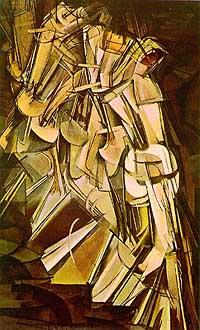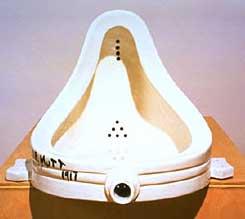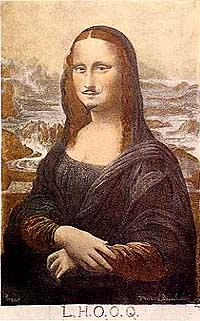|
Marcel Duchamp
by Max May
"(I am) an-artist,
chess player, cheese dealer, breather, fenêtrier" -
Duchamp ¹
|
Henri-Robert-Marcel Duchamp was born on July 28,
1887, at Blainville-Crevon (near Rouen), France. Duchamp was
the third of six children born to M. Eugène and Madame
Duchamp. From the early age Duchamp was exposed to arts, Madame
Duchamp was a talented amateur musician, and her father had
been a shipping agent with a strong interest in painting and
engraving. Duchamp had two elder brothers, Gaston (who was born
in 1875 and later took the name Jacques Villon, and was
himself a famous painter) and Raymond Duchamp-Villon
(born in 1876 and was an accomplished sculptor who died during
World War I). Duchamp’s younger sister, Suzanne had an
interest in arts and was a poetess.
|
|
In 1904 Duchamp joined his two elder brothers
in Paris where he studied painting at the Academie Julian until
1905. During that time Duchamp drew cartoons and illustrations
for satirical publications Courrier Francais and Le
Rire. Duchamp began painting around 1908, his early works
were Post-Impressionist in style. In 1909 Duchamp exhibited
for the first time at the Salon des Indépendants
and Salon d’Automne in Paris. In 1911 he was a member
in the painters' circle known as the "Golden Section",
together with La Fresnaye, Léger, Metzinger, Picabia,
and others. Influenced by cubism Duchamp painted the picture
"The Chess Players" and the first studies for his "Nudes
descending a Staircase". Also, in the same year Duchamp
created The Coffee-Mill.
|
|

Nude Descending a Staircase, No. 2
|
|
In 1912, he painted his masterpiece Nude Descending
a Staircase, No. 2 portraying continuous movement through
a chain of overlapping cubistic figures. The painting was rejected
by the Salon Des Indépendants. However, it was
shown at a cubist exhibition in Barcelona, Spain, and in Paris
at the Salon de la Section d'Or and subsequently created
great controversy at the Armory Show in New York in 1913,
which made Duchamp famous in America.
|
|
In 1913 Duchamp began to produce "ready-mades",
mundane objects taken out of context by the artist, made unusable for
their original purpose and presented as works of art.
Talking about "ready-mades" Duchamp said,
|
"In 1913 I had the happy idea to fasten
a bicycle wheel to a kitchen stool and watch it turn . . . In
New York in 1915 I bought a hardware store shovel on which I
wrote 'in advance of the broken arm.' It was around that time
that the word 'readymade' came to mind to designate this form
of manifestation. A point which I want very much to establish
is that the choice of these 'readymades' was never dictated
by esthetic delectation. This choice was based on a reaction
of visual indifference with at the same time a total absence
of good or bad taste. I realized very soon the danger of repeating
indiscriminately this form of expression and decided to limit
the production of 'readymades' to a small number yearly. I was
aware at that time, for the spectator even more than for the
artist, art is a habit-forming drug and I wanted to protect
my 'readymades' against such contamination." ²
|
| Duchamp
painted very little after 1915, although he continued until 1923
to work on his masterpiece The Bride Stripped Bare by her
Bachelors, Even, an abstract work, also known as The
Large Glass, a metal and glass construction nine feet
high, that was enthusiastically received by the surrealists. |
 "The Large Glass"
"The Large Glass"
|
|
|

"Fountain"
|
|
In
1915 Duchamp went to America. In 1917 the Society
of Independent Artists is formed, with Duchamp as
a founding member, and later a director. He submits
the notorious ready-made Fountain under
the pseudonym R. Mutt to an Independents exhibition,
which is rejected. As a result, Duchamp resigns from
the Society. As a work of art, Fountain contributed
to his notoriety as did, in 1920, a reproduction of
the Mona Lisa with added beard and mustache.
Also in 1920 Duchamp created a female alter ego named
Rrose Selavy, subsequently associated with puns
and ready-mades. In the same year Duchamp, Katherine
Dreier and Man Ray form the first museum
of modern art in the United States, the Société
Anonyme, Inc.
|
|

"L.H.O.O.Q"
|
|
Duchamp gave up creative work in 1923 to organize exhibitions,
edit a magazine, experiment with film and play chess. He became
increasingly absorbed by chess and by 1928 was a member of the
French Olympic team at Hague. In 1925 Duchamp suffered a tragedy
when his mother died on January 29 and his father just a few
days later on February 3. In 1927, Duchamp had a brief marriage
to Lydia Sarazin-Lavassor, which only lasted a few months. He
married again in 1954 to Alexina (Teeny) Sattler in New York.
In the same year, Large Glass was installed permanently
in the Philadelphia Museum of Art, together with a large
number of his other works. Duchamp settled permanently in New
York in 1942 and became a United States citizen in 1955.
|
|
During the 1940s, he associated and exhibited
with the Surrealist émigrés in New York, and in
1946 secretly began Etant donnés: 1. la chute d’eau
2. le gaz d’éclairage… (Given: 1degree the waterfall,
2 degrees the illuminating gas…), a major assemblage on
which he worked secretly for the next 20 years. It was installed
in the Philadelphia Museum of Art and shown publicly for the
first time after his death.
While Duchamp’s work had an effect on the anti-arts
movement, in 1962 he acknowledged failure, "I thought to
discourage aesthetics... I threw the bottlerack and the urinal
in their faces and now they admire them for their aesthetic
beauty". Duchamp died at Neuilly on October 1, 1968 and
is buried in Rouen, with an inscription on his grave in his
own words: "D'ailleurs c'est toujours les autres qui meurent"
(but it's always other people that die).
|
References:
¹ http://www.marcelduchamp.net/whois/whois1.htm
² http://www.walkerart.org/resources/res_pc_duchamp.html
http://www.beatmuseum.org/duchamp/images/bride.jpg
http://www.sfmoma.org/images/ma/collections/recent_detail/duchamp_fountain.jpg
http://www.zumbacombo.com/duchamp/images/works/lhooq.jpg
http://www.beatmuseum.org/duchamp/images/nude2.jpg
|



